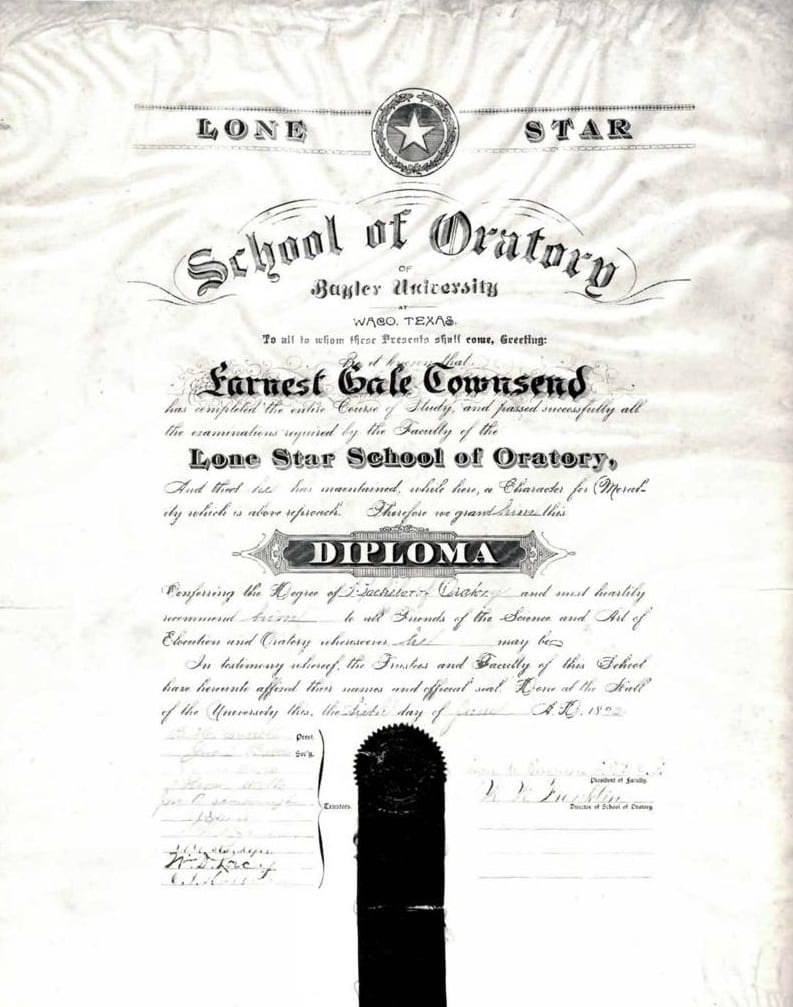Our Sharing Student Scholarship blog posts showcase original scholarship written by Baylor students who conducted research using primary source materials in The Texas Collection. This post is the first of five in a series of blog posts written by graduate and PhD students from the Fall 2018 Foundations & History of Higher Education Leadership course.
by Beth Benschoter, Delacy Carpenter, Liya Scott, and Zach Mills
The transition from the 19th Century and into the 20th Century was a time in American higher education of innovation and reform. Although within a matter of decades a uniquely American identity of higher education would emerge, at the turn of the century institutions were still experimenting, specifically with curriculum (Thelin, 2011). This was certainly true of Baylor University and from ~1890-1910, Baylor was exploring many curricular innovations, some lasting and others not. Four specific curricular changes that emerged during this time were: the construction of a new science building; a military science department; a growing religious curriculum; and a school of oratory.
Carroll Science Hall
The construction of Carroll Science Hall allowed for Baylor to remain competitive, increase enrollment, and expand curriculum as students and faculty were inspired by the dedication to education in the fields of science and medicine. In 1901, George Carroll announced his donation of $60,000 (Dawson, 1901, May 4) for the construction of a new science building, which brought new technology and improved lab equipment. The impact of scholars such as Hallie Earle and Lula Pace (Earle, n.d.; Pace, 1900-1949) inspired students to continue pursuing science through research and medicine. The progression of the sciences would continue to carry Baylor towards growth and innovation.
Religious Education
While many institutions were breaking away from their religious ties during the turn of the century, Baylor remained steadfastly connected to theirs. Baylor’s religious curriculum during this time was robust. Classes that students took included Missions, Hebrew, and Practical Theology, among others (Baylor University, 1906). Students were able to take religion classes as electives and student interest in these types of classes led to the building of a seminary (Baylor University, 1908). Religious curriculum was a part of life outside the classroom as well, with students participating in organizations such as The Mission Band and the Student Christian Association (Baylor University, 1909).
Although it only lasted 16 years, the Baylor department of Military Science and Tactics contained an impressive Cadet Corps (Baylor University, 1895-96). The Corps provided Baylor men physical fitness training and military knowledge (Baylor University, 1896b). Men of the Corps were known for their clean-cut appearance, impressive marching routines, and weekly rifling drills (Watson, 1968). Students were required to attend theoretical courses that offered knowledge of the U.S. Army, National Guard, military courts, and law (Baylor University, 1893; 1894; 1895; 1896a). Starting in 1895, membership in the Corps was required for all males at the university (Baylor University, 1895-96). Upon completion of the program, men gained an understanding of military tactics and a comprehensive knowledge of the United States military.
The Lone Star School of Oratory
 The Lone Star School of Oratory enjoyed a short but successful tenure at Baylor. At its height it enjoyed the largest enrollment of any single division and at its low it suffered an abrupt and unheralded demise (Baker, 1987). The school was headed by the charismatic W. W. Franklin, and the course of study was based upon two equally important elements, voice and gesture (Baylor University Lone Star School of Oratory, 1892). For reasons not known, in 1894 Franklin was not re-elected to his position and he moved the The Lone Star School of Oratory to Dallas, no longer associated with Baylor (Baylor University, 1896b).
The Lone Star School of Oratory enjoyed a short but successful tenure at Baylor. At its height it enjoyed the largest enrollment of any single division and at its low it suffered an abrupt and unheralded demise (Baker, 1987). The school was headed by the charismatic W. W. Franklin, and the course of study was based upon two equally important elements, voice and gesture (Baylor University Lone Star School of Oratory, 1892). For reasons not known, in 1894 Franklin was not re-elected to his position and he moved the The Lone Star School of Oratory to Dallas, no longer associated with Baylor (Baylor University, 1896b).
Conclusion
Although not all curricular innovations lasted, collectively they helped shape the curricular identity of Baylor. While military and oratory education did not survive, competitive science and religious education are hallmarks of Baylor today. Much like the rest of the nation, the transition from the 19th into the 20th Century was a time of curricular experimentation at Baylor University.
References
Baylor University Lone Star School of Oratory. (1892). Seventh annual catalogue of the Lone Star School of Oratory. The Texas Collection, Baylor University, Waco, TX.
Baylor University. (1906). The Round Up. Waco, TX: Baylor University.
Baylor University. (1908). The Round Up. Waco, TX: Baylor University.
Baylor University. (1909). The Round Up. Waco, TX: Baylor University.

No Comments